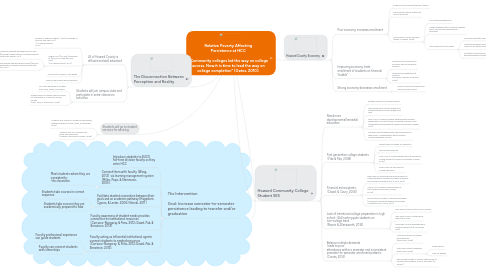
1. Students will go to student services for advising
1.1. Students look online for answers to graduation pathway questions (Miller, Pope, & Steinmann, 2005)
1.2. Students see HCC advisors less often than past years (Howard Community College, 2013b)
2. The Disconnection Between Perception and Reality
2.1. All of Howard County is affluent and well educated
2.1.1. Bachelor's degree or higher = 60% (compared to 36% MD and 29% USA) (US Census Bureau, 2014)
2.1.2. Median HHI $107,000 (compared to $73,000 MD and $53,000 USA) (US Census Bureau, 2014)
2.1.2.1. Clarksville average adjusted gross income $160,068 (Department of Planning Maryland State Data Center, 2011)
2.1.2.2. Jessup average adjusted gross income $58,464 (Department of Planning Maryland State Data Center, 2011)
2.1.3. Community college is "13th grade"
2.1.4. Push for high school dual enrollment
2.2. Students will join campus clubs and participate in extra-classroom activities
2.2.1. Too many demands on student time: work, family, and school
2.2.2. Students want to attend class and leave, not interested in a social life around college (Miller, Pope, & Steinmann, 2005)
3. The Intervention Goal: Increase semester-to-semester persistence leading to transfer and/or graduation
3.1. Introduce students to BUCO full-time division faculty as they enter HCC
3.2. Connect them with faculty (Wang, 2012) via learning management system (Miller, Pope, & Steinmann, 2005).
3.2.1. Meet students where they are consistently: the classroom
3.3. Facilitate student connection between their goals and an academic pathway (Hagedorn, Cypers, & Lester, 2008; Nitecki, 2011 )
3.3.1. Students take courses in correct sequence
3.3.2. Students take courses they are academically prepared to take
3.4. Faculty awareness of student needs provides connection to institutional resources (Carrasco-Nungaray & Pena, 2012; Dowd, Pak, & Bensimon, 2013)
3.5. Faculty acting as influential institutional agents connect students to needed resources (Carrasco-Nungaray & Peña, 2012; Dowd, Pak, & Bensimon, 2013).
3.5.1. Faculty professional experience can guide students
3.5.2. Faculty can connect students with internships
4. Howard Community College Student SES
4.1. Need more developmental/remedial education
4.1.1. Extends number of courses required
4.1.2. Few college level courses available to students without proper college-level skills
4.1.3. 60% of HCC Students require Developmental English, mathematics or both (Office of Planning, Research, and Organizational Development Howard Community College, 2014)
4.1.4. Students have struggled with math and English in high school--unenthusiastic about starting college with these courses
4.2. First generation college students (Fike & Fike, 2008)
4.2.1. Parents have not saved for education
4.2.2. Lack support at home
4.2.3. 40% of HCC credit students are first generation college students (Howard Community College, 2013c)
4.2.4. Family may not see need for college education
4.3. Financial aid recipients (Dowd, & Coury, 2006)
4.3.1. New rules for accessing financial aid based on State mandates (College and Career Readiness and College Completion Act of 2013, 2012)
4.3.2. 40% of HCC students receive financial aid (Howard Community College, 2013b)
4.3.3. Time limits for number of semesters available (College and Career Readiness and College Completion Act of 2013, 2012)
4.4. Lack of intentional college preparation in high school--Skill sorting puts students on non-college track (Naomi & Allensworth, 2014)
4.4.1. Less likely to take SAT/ACT prep courses
4.4.2. Less likely to be on college prep high school track
4.4.3. More likely to be underprepared in math and English (not on college level)
4.5. Balance multiple demands leads to poor attendance within a semester and inconsistent semester-to-semester enrollment patterns (Crosta, 2014)
4.5.1. Must work to pay for college simultaneously (Fike & Fike, 2008)
4.5.2. Often have family obligations (Fike & Fike, 2008)
4.5.2.1. Single parent
4.5.2.2. Care for siblings
4.5.3. Take enough credits to receive financial aid (12 credits) not enough to finish in two years (15 credits)
5. Howard County Economy
5.1. Poor economy increases enrollment
5.1.1. Fewer full-time faculty/staff per student
5.1.2. Adult learners return as they are laid off from jobs
5.1.3. More adjunct faculty are hired (Eagan, & Jaeger, 2009).
5.1.3.1. Lack teaching experience
5.1.3.2. Maybe teaching just to make up financial short-fall (not really dedicated to teaching)
5.1.3.3. Lack connection to students
5.1.3.3.1. Only teach one/two classes
5.1.3.3.2. Institutional doesn't provide resources for adjunct offices
5.1.3.3.3. Institution doesn't focus on developing adjunct faculty
5.2. Improving economy limits enrollment of students on financial "bubble"
5.2.1. Students may not persist as economy and job prospects improve
5.2.2. Financial aid obligations not "worth it" (Mendoza, Mendez, & Malcolm, 2009).
5.3. Strong economy decreases enrollment
5.3.1. Tends to limit enrollment to the most financially needy
